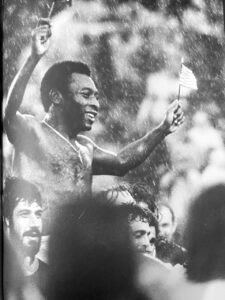
A person’s greatness is truly reflected in the unabashed following transcending his or her own domain and generations beyond his or her own. Pele’s popularity leapfrogs football and straddles several decades. It can be said without fear of contradiction that his magic brought cheer to many, touching the lives of people around the world.
In my pre-teen years when newspapers ruled the roost, Muhammad Ali was the only sporting icon bigger than him. Track and field star Jesse Owens, Hockey wizard Dhyan Chand, Tennis legend Rod Laver, Cricket great Sir Donald Bradman, Formula One hero Juan Manuel Fangio and ace jockey Lester Piggot held their own, but Ali and Pele won the popularity stakes. Easily.
I remember reading about an incident many years ago when he was conducting a football clinic in Malta. The Governor and Prime Minister had dropped by to interact with him. He excused himself from the conversation to walk across to the pitch, get down on his knees to tie the shoelaces of a boy. It is this simplicity that endears him to everyone.

“Through simplicity and sincerity, you can put all humankind together,” believed the only man with three FIFA World Cup titles. He did his bit to popularise football in the United States by playing for New York Cosmos after he retired from an 18-year career with Santos. He was truly the biggest commercial attraction in the world of sport.
People know he had several nicknames –Dico, Perola Negra (Black Pearl), O Rei, Pele – to go with his name, Edson Arantes do Nascimento. But he had one amazing identity that found a way to people’s hearts and memories. That he earned the respect of not just his team-mates and opponents but also those who watched him play and shared his knowledge with.
In 1999, the International Olympic Committee named Pele the Athlete of the Century, though he never appeared in the Olympic Games. And the following year, FIFA named him and Diego Maradona jointly as the Player of the Century. He won many more accolades for his athleticism, flair and skill. He was the reason for warring folk in Nigeria to ceasefire in the 60s.
Of course, anyone who watched his matches on TV or YouTube will know that Pele had speed, power, explosiveness, physical and mental toughness as well as imagination and vision. These and other qualities combined to make him the great artist that he clearly was. But I will leave it to better students of football and more eloquent writers to describe all these.
It is not as if Pele’s life was a bed of roses. A shoeshine boy in his early years, he later flirted with bankruptcy twice, endured two failed marriages, lost a paternity suit were milestones that were part of his journey. None of that frailty seemed to take anything away from his leaving an indelible print on countless minds.
Long after he hung his boots, Pele not only acted as Corporal Luis Fernandez but also designed the football plays in John Huston’s war movie Escape to Victory (1981). A couple of years later, the film was playing in a 70mm theatre, Safire, in Madras. I remember the audience impulsively rising to its feet when he scored a goal with a scissors kick.
It must have taken a lot for him to let goalkeeper Capt. Robert Hatch, played by Sylvester Stallone, steal the thunder in the end with a spectacular save off a last-minute penalty kick, but clearly Pele the football artist let Pele the designer hold the edge. For the second time in a few minutes, the audience rose as one as if it were responding to the plays in a stadium.
And until he is laid to rest in a Santos cemetery, football lovers and all else around the world will rise in farewell to Pele, the man with an endearing smile and magical footballing skills.








Well written. Brings very evocative memories of him.